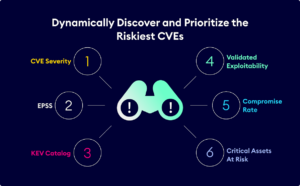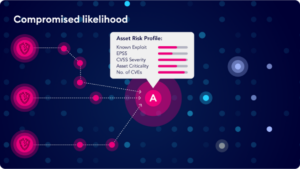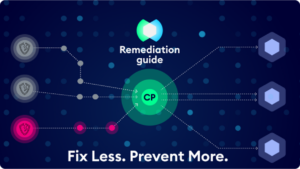What is Vulnerability Risk Management?
The next generation of risk-based vulnerability management is here, with dynamic and continuous CVE mapping that allows you to seamlessly pivot security context from a traditional to a transformative RBVM construct. Prioritize your viewpoint of vulnerabilities from exploit likelihood to business impact risk and streamline the mobilization of remediation efforts, with rich contextual guidance, to justify actions and proactively accelerate security operations.
The Problem with Traditional Vulnerability Management
Diverse asset types, spread across a distributed attack surface, along with the growing severity of vulnerabilities all culminate in a widening remediation deficit.
Traditional tools with inaccurate scanning methodologies generate high volumes of false positives that contain limited, if any, context for action. The result is even the most well-defined operating processes are difficult to put into action.
Solutions that continue to view risk posture in the context of individual assets, or that fail to consider compensating controls result in a flawed and ineffective prioritization logic – and offer very little in the way of real-world validation.
Unclear ownership of assets and the lack of justification for action make it challenging for security teams to prioritize efforts, based on their limited understanding of the business risk presented by each vulnerability.
What are the Key Capabilities of Vulnerability Risk Management?
It’s time for a new approach to Vulnerability Management
Revolutionize your vulnerability management processes, with contextual risk quantification, that uniquely correlates intrusion likelihood with validated business impact risk, allowing you to focus remediation and patching efforts on high-impact vulnerabilities.
Innovative Discovery and Dynamic Mapping
Continuous and dynamic discovery of vulnerabilities across hybrid infrastructure that ensures accurate CVE mapping to diverse risk attributes.
Traditional to Transformative Risk Context
Seamlessly pivot security context from intrusion risk to business impact risk, based on the true exploitability of an individual CVE, Device, or Product.
Impact-based Risk Prioritization
Know where to focus, with the complete picture of vulnerability risk based on the impact to business critical assets.
CVE Exploitability Validation
Take the guesswork out of CVE Risk analysis, by correlating exploit kits and attack techniques to CVEs and validating their exploitability in your environment.
Remediation Mobilization
Ensure your teams have the justification, prioritization, and remediation guidance they need to accelerate closed-loop vulnerability patch management.
What are the Features and Benefits of Vulnerability Risk Management?
Continuous Discovery of CVEs through the XM Cyber lightweight sensor for accurate discovery assessment of the device profile, configuration state, and related software.
Dynamic Mapping of the risk attributes and exploitability characteristics of vulnerabilities, via our cloud-hosted dynamic dictionary of trusted vulnerability catalogs.
Vulnerability Attributes, including CVE Severity, Common Vulnerability Scoring System (CVSS), Exploit Prediction Scoring System (EPSS), Exploited in the Wild, Exploit Kit Exists, and associated Attack Technique.
Device Attributes, including Operating System, number of CVEs, Severity of CVEs, Compromise Risk Score, Choke Point Indicator, Asset Criticality, Number of affected entities, and the percentage of Critical Assets at Risk.
Product Attributes, including the number of vulnerabilities for the product, the total distribution of the product along with the number of critical assets and choke points the product is found on, and the percentage of critical assets at risk as a result.
XM Cyber Attack Graph Analysis™ provides both exploitability validation of the CVEs along with the unique business impact base prioritization logic calculated through attack path modelling.
Compromise Risk Score calculated based on the inbound risk of compromise for each device based on the number of proceeding breach points, and the complexity of the attack paths toward the device, as a factor of the likelihood of the device being exploited.
Choke Point Identification to uniquely identify choke points where many attack paths converge. Remediate these spots to stop attackers from advancing to your critical assets.
Critical Assets at Risk, calculated based on the outbound risk of threat propagation that would result if the vulnerability, device, or product was exploited during an attack, based on the percentage of critical assets that would be compromised as a result.
Remediation Guidance, for flexible context-based guidance for CVE patching, infrastructure hardening, and security best practices, to handle even the most complex of environments and operational constraints.
Automated Ticket Creation streamlines Security operations through the mobilization of vulnerability management through integrations with your ITSM solution.
How to Operationalize Vulnerability Risk Management
Continuous Discovery
The XM Cyber Vulnerability Risk Management module utilizes a lightweight sensor to dynamically assess the configuration state and registry settings of devices, software and products on a continuous basis, to dynamically map vulnerabilities and CVEs via a cloud-hosted dynamic dictionary.
Taking a Traditional Approach to Vulnerability Prioritization
Flexible contextual views of vulnerabilities by CVE, Device, or Product context, which allows IT operations teams to prioritize vulnerabilities based on the risk attributes in line with a traditional approach to vulnerability management.
For individual CVEs, prioritization is provided through risk attributes such as CVSS Severity or EPSS Score. The Prioritization logic also includes flagging CVE that have been exploited in the wild and are being tracked on the CISA Known Exploitable Vulnerability Database. All these risk attributes count towards the individual exploit likelihood of the CVE.
Operators can see the distribution of each CVE across devices to help assess the remediation effort, or to pivot their viewpoint to that of the device or product context.
By focusing on devices, IT Operations can now understand the overall risk presented by a device based on the number and severity of the CVEs related to its Operating Systems, underlying hardware, and the software products it has installed.
The Product view allows IT Operations to prioritize the highest-risk products, based on the number of CVEs, the scale of their deployment, and their wide-reaching implications.
A Transformative Approach to Vulnerability Prioritization
Every exposure discovered by the XM Cyber CEM platform, including CVEs, are continuously analyzed through XM Attack Graph Analysis™ to see how they chain together into attack paths that target critical assets.
For Vulnerabilities, the first step in this process is to map CVEs with exploit kits and their associated attack techniques, and then verify their exploitability on the individual device. Once identified as exploitable, all potential lateral movements from the device are then verified via the XM Sensor. This unique attack path validation can then be utilized for enhanced prioritization logic:
- Attack Technique – Where a known exploitable vulnerability has been proven to be exploitable in your specific environment.
- Compromise Risk Score – The inbound risk of compromise based on the number of breach points available and the complexity of hops required by an attacker to reach and exploit the device.
- Affected Entities – The number of entities that an attacker can directly compromise by exploiting the vulnerabilities on the device.
- Critical Assets at Risk – The outbound or onward business impact risk based on the percentage of critical assets that would result from an attacker exploiting the device.
These unique risk attributes allow Security teams and IT Operations to see their environment through the eyes of the attacker, and transform their approach to vulnerability prioritization, based on validated exploitability and business impact risk.
Effective Mobilization
After the validation of exploitability and the prioritization of vulnerabilities through the XM Attack Graph Analysis™, the XM Cyber platform goes a step further by providing remediation guidance in the form of playbooks that can be used by IT Operations teams to implement the required actions.
If the CVE can be patched, a remediation guide will be provided that outlines where the patch can be found, and how it should be applied. However, not all vulnerabilities can be patched, either due to the reliance on a legacy system, limited maintenance windows, or when a patch is simply not yet available. In these instances, the XM Cyber Platform will provide two additional types of playbooks. These will either be in the form of a hardening guide or a best practices guide, each of which contains a combination of information and guidance from the specific vendor, along with insights from the XM Cyber security research experts.
Workflow automations can then be initiated through the XM Cyber Platform integrations with leading ITSM tools, ticketing solutions, and SOAR platforms. Operators can create a new task from any remediation guidance in the platform, assign the ticket to the relevant teams, and attach the XM Cyber remediation guide, to ensure the right people have the information they need to implement effective remediation and response actions to critical and high-risk vulnerabilities.
What Business Value Outcomes are Achieved with VRM?
XM Cyber Vulnerability Risk Management provides an innovative new approach to discover, quantify, and reduce the risk presented by Vulnerabilities, which combines with the XM Attack Graph Analysis™ for enhanced exploitability validation, enabling a more effective approach to vulnerability management.
Transformative Vulnerability Remediation
Flexible contextual views of vulnerabilities with unique prioritization & validation logic, that allows you to seamlessly pivot your security viewpoint from traditional to transformative Risk-Based Vulnerability Management.
Impact-based Risk Reporting
Comprehensive vulnerability risk quantification, that validates which vulnerabilities present the greatest risk to the business, based on both the inbound compromise risk score, and the onward Impact risk towards critical assets.
Collaborative Security Optimization
Foster a culture of collaboration and ensure all your teams have the information they need to tackle vulnerability risk. Accelerate closed-loop vulnerability patch management, with the justification, prioritization, and remediation guidance needed to ensure the effectiveness of defensive strategies.
How Does XM Cyber VRM Differ From Traditional Vulnerability Management?
Most Comprehensive Platform for CTEM
We extend vulnerability management to exposure management and allow organizations to rapidly adopt a Continuous Threat Exposure Management (CTEM) approach to proactive risk management.
Choke Point Identification
XM Cyber Attack Graph Analysis™ uniquely identifies choke points where many attack paths converge. Remediate these high-risk entities to stop attackers from advancing to your critical assets.
Continuous Discovery and Prioritization
Move away from inaccurate periodic scans for CVEs, that result in a high volume of false positives with ineffective prioritization logic.
Traditional VM tools provide limited context on the true exploitability of vulnerabilities and only calculate risk based on individual asset logic, without considering the wider attack surface and the broader set of exposure risks, such as misconfigurations, and identity issues.
Exploitability Validation and Impact Based Prioritization
XM Cyber VRM leverages the XM Attack Graph Analysis™ to correlate all forms of exposure risk, to validate exploitability, and quantify the risk each vulnerability presents to business critical assets. This allows SecOps teams to seamlessly pivot their cybersecurity risk viewpoint and context.
Remediation Guidance That Powers Action
XM Cyber provides detailed recommendations and remediation playbooks for all vulnerabilities across CVEs, devices, and products. Each remediation playbook contains step-by-step guides, which can be automatically attached to Tickets in your ITSM solution to ensure the right teams have the information they need to optimize remediation efforts.
To further optimize the mobilization of remediation efforts, the XM Cyber platform provides guidance on security best practices and additional countermeasures that can be implemented when CVE patching is not possible, due to legacy systems, or other factors that limit the installation of vendor supplied fixes and patches.
The XM Cyber Platform
XM Cyber Vulnerability Risk Management is an add-on module to the XM Cyber Continuous Exposure Management Platform that transforms the way organizations approach cyber risk.
XM Cyber gives you the context you need to make faster and more confident decisions about which exposures to fix first and which can wait. Automatically discover all the attack paths in your environment to clearly see which vulnerabilities, misconfigurations, and identities chain together to pose the greatest risk.
Now you can stop wasting time on exposures that don’t open attack paths to critical assets – the dead ends. Instead, leverage the power of attack graphs to automatically pinpoint the exact spots – the choke points – where you can disrupt the attacker’s path.
See all ways, and accelerate remediation efficiency, by ensuring your IT and Security Operations teams have the guidance they need to mobilize effective remediation strategies, helping you Fix Less. Prevent More.









